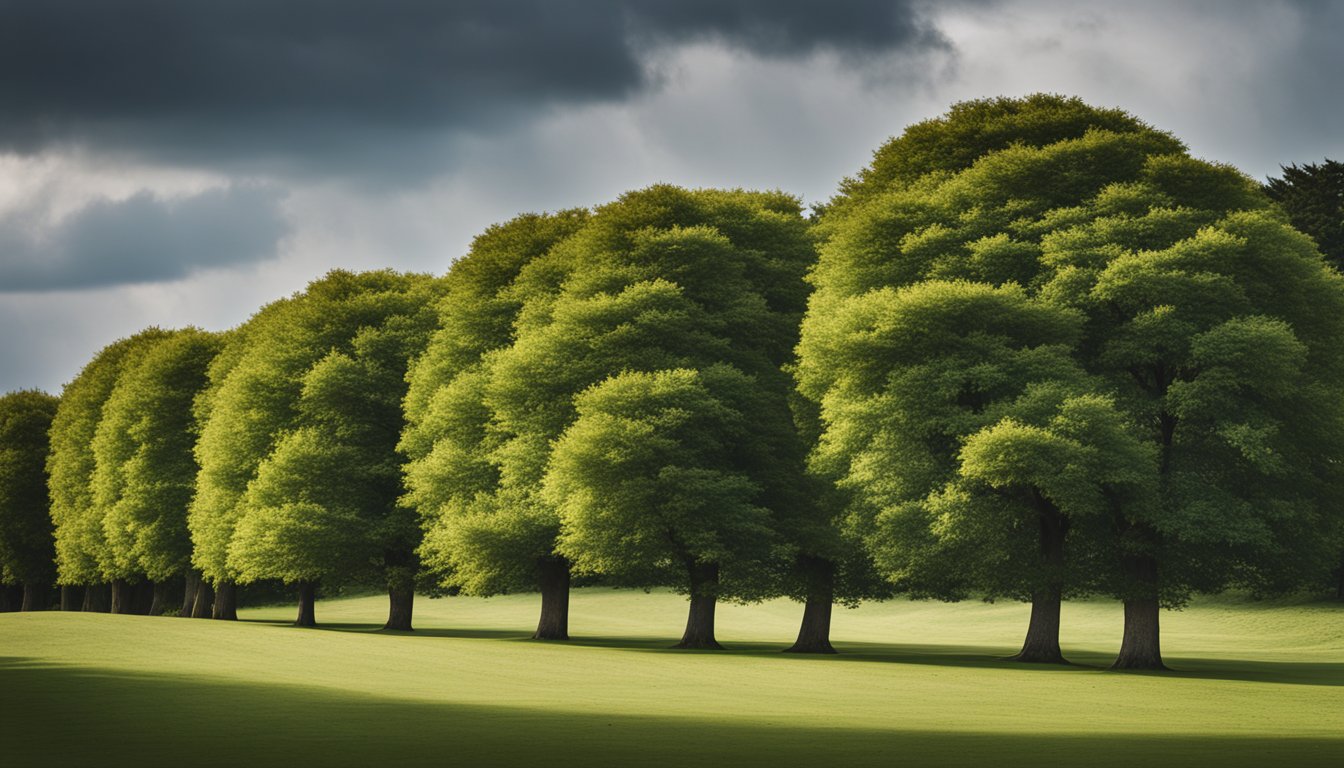Late updated: 16 Jul 2024 08:07
Written by: Emily Thornton
Best Native UK Trees For Windbreaks: Top Choices for Effective Shelter
When planning a windbreak for your property in the UK, choosing the best native trees can make a significant difference. Native trees offer numerous benefits such as better adaptation to local climates and support for local wildlife. Alnus glutinosa, commonly known as the native alder, is an excellent choice due to its rapid growth, often reaching up to 1 metre per year. This makes it highly effective for quickly establishing a protective barrier.

Another strong candidate for windbreaks is the silver birch (Betula pendula). This tree not only provides an effective wind barrier but also adds visual interest with its golden-yellow autumn foliage. Furthermore, it thrives in a variety of soil conditions, making it a versatile option for different garden setups.
Lastly, let's not overlook the field maple (Acer campestre). This tree is not only resilient but also supports local ecosystems by providing habitat and food for various insects and birds. By incorporating these native species into your windbreak, you not only enhance your property's protection but also contribute positively to the environment.
Key Takeaways
- Native trees like Alnus glutinosa grow quickly and adapt well.
- Silver birch offers effective wind protection and seasonal beauty.
- Field maple supports local wildlife and adds resilience.
Selecting the Right Species for Windbreaks

Choosing the best species for windbreaks involves understanding the unique benefits of native trees, the form and function of windbreaks, and the differences between evergreen and deciduous species.
Considering Native Trees and Their Benefits
Selecting native trees offers several advantages. Native species are well-adapted to local soil, climate, and weather conditions, reducing the need for extensive maintenance. They provide robust habitats for wildlife, enhancing biodiversity.
For example, Alnus glutinosa (common Alder) thrives in wet soils, making it suitable for damp areas. Another excellent choice is Quercus robur (English Oak), known for its strong structure and longevity. These trees contribute significantly to our windbreak effectiveness by providing resilient, long-lasting barriers.
Understanding the Form and Function of Windbreaks
The structure of windbreaks dramatically impacts their efficiency. A well-designed windbreak typically consists of multiple rows of trees and shrubs, which reduce wind speed and protect against erosion. The density and height of the planting influence the level of protection offered.
Shelterbelts, a type of windbreak, are particularly effective. They consist of several rows of trees and shrubs, providing layered protection. The combination of different species can create a more effective barrier, balancing height and density for maximum wind reduction. Planting in staggered rows can also enhance air turbulence and increase coverage.
The Importance of Evergreen Versus Deciduous Species
Choosing between evergreen and deciduous species depends on the desired windbreak functions. Evergreens, such as Ilex aquifolium (Holly) and Pinus sylvestris (Scots Pine), offer year-round protection. These species are invaluable in providing consistent wind resistance and privacy throughout the seasons.
In contrast, deciduous trees, like Acer campestre (Field Maple) and Betula pubescens (Downy Birch), shed leaves in winter but support biodiversity during other times. They are excellent for regions where seasonal variation in windbreak effectiveness is acceptable.
Combining both types can offer the best protection. Evergreens provide constant cover while deciduous species add diversity and robust seasonal growth. The mix ensures continuous protection and enhances the ecological value of the windbreak.
Designing and Planting Effective Windbreaks

Creating an effective windbreak involves proper structuring of rows, strategic spacing, and mindful planting. We’ll emphasise the importance of staggered rows and appropriate spacing to ensure optimal wind protection and plant health.
Structuring Your Windbreak: Staggered Rows and Spacing
When structuring windbreaks, staggered rows provide the most effective shelter. By planting trees and shrubs in staggered formations, we break up wind flow, reducing its speed and force.
Spacing is crucial. Small shrubs should be spaced 30-90 cm apart, while large trees require 2-4 metres. Correct spacing enhances growth cycles, ensuring that plants do not compete excessively for resources.
Maintenance is another key factor. Regular pruning and monitoring ensure that foliage remains dense, providing consistent shelter. Careful soil management promotes healthy stems and robust growth.
By following these guidelines, we can establish durable windbreaks that protect gardens and fields from harsh winds, fostering a more stable environment for all plants.
Frequently Asked Questions
When planning a native UK windbreak, it's important to consider species that are effective at reducing wind speed, provide year-round cover, and are well-suited to the local climate.
Which native British trees provide the most effective wind protection?
Among native British trees, the common beech (Fagus sylvatica) and the hornbeam (Carpinus betulus) are excellent for wind protection. These trees have dense foliage and sturdy structures that help break the wind and provide a substantial barrier.
What are the best British evergreen species for creating a perennial windbreak?
Evergreen species like the Scots pine (Pinus sylvestris) and holly (Ilex aquifolium) offer consistent, year-round protection. Their foliage remains lush through winter, ensuring the windbreak's effectiveness doesn't diminish during colder months.
Can Alder trees serve as a good wind barrier in the UK?
Yes, alder trees (Alnus glutinosa) are well-suited for use as windbreaks in the UK. They grow quickly and have dense canopies that help in reducing wind speed, making them a practical choice for creating effective barriers.
What garden shrubs native to Britain are suitable for windbreaks?
Garden shrubs such as hawthorn (Crataegus monogyna) and blackthorn (Prunus spinosa) are effective for windbreaks. These shrubs are not only hardy but also produce dense foliage, contributing significantly to wind reduction.
Which trees are recommended for windbreaks in exposed UK gardens?
For exposed gardens, trees like the field maple (Acer campestre) and the willow (Salix spp.) are recommended. These species are resilient to harsh conditions and can provide the necessary protection against strong winds.
How can one create a free-standing windbreak in a UK garden using native plants?
To create a free-standing windbreak, we should plant a mix of trees and shrubs in staggered rows. Using a combination of tall trees like oak (Quercus robur) and shorter shrubs ensures that the barrier is dense at multiple heights. This layered approach maximises wind reduction and enhances the garden's aesthetic appeal.
